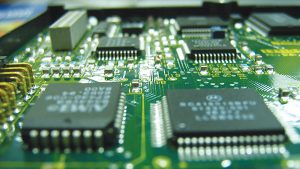Bloomberg
Micron Technology Inc, the largest US maker of memory chips, said the worst industry glut in more than a decade will make it difficult to return to profitability in 2023.
The company announced a host of cost-cutting measures, including a 10% workforce reduction, aimed at helping it weather a rapid drop in revenue. Micron also projected a steep sales decline and a wider loss than analysts had estimated for the current quarter.
Semiconductor makers are in the midst of plummeting demand for their products less than a year after being unable to produce enough to meet orders. Consumers have shelved purchases of personal computers and smartphones amid rising inflation and an uncertain economy.
Makers of those devices, the main buyers of memory chips, are now stuck with stockpiles of components and are slowing orders for new stock.
The industry is experiencing its worst imbalance between supply and demand in 13 years, according to Micron Chief Executive Officer Sanjay Mehrotra. Inventory should peak in the current period, then decline, he said. Customers will move to more healthy inventory levels by about the middle of 2023, and the chipmaker’s revenue will improve in the second half of the year, Mehrotra said.
“Profitability will be challenged throughout 2023 because of the oversupply that exists in the industry,†he said in an interview. “The rate and pace of the recovery in terms of profitability depends on how fast supply is brought into line.â€
Mehrotra said a unique convergence of circumstances — the war in Ukraine, a surge in inflation, Covid and supply disruptions — has thrust the memory chip industry into a
repeat of past cycles when prices plummeted and wiped out profits. Micron has responded aggressively to try to quickly get through the difficult period. One the downturn is over, the industry will resume profitable growth helped by demand for artificial intelligence computing and automation of various industries, he said.
Micron, which had already announced factory output reductions, is cutting its budget for new plants and equipment, and now expects to spend from $7 billion to $7.5 billion for the fiscal year, a decline from an earlier target of as much as
$12 billion. The company is slowing the introduction of more advanced manufacturing techniques and predicts that spending on new production will fall throughout the industry.
Unlike other parts of the chip sector, products from Micron are built to industry standards, meaning they can be swapped out for those of its competitors. Because memory can be traded like a commodity, its makers are exposed to more pronounced price swings.
 The Gulf Time Newspaper One of the finest business newspapers in the UAE brought to you by our professional writers and editors.
The Gulf Time Newspaper One of the finest business newspapers in the UAE brought to you by our professional writers and editors.
